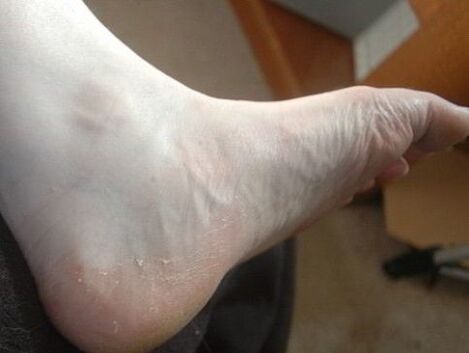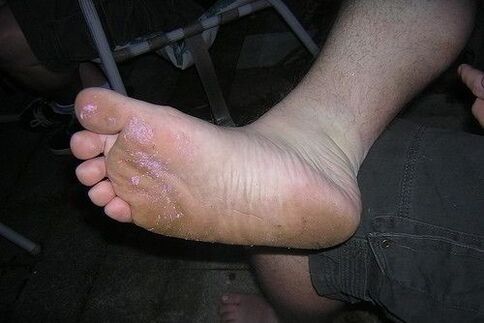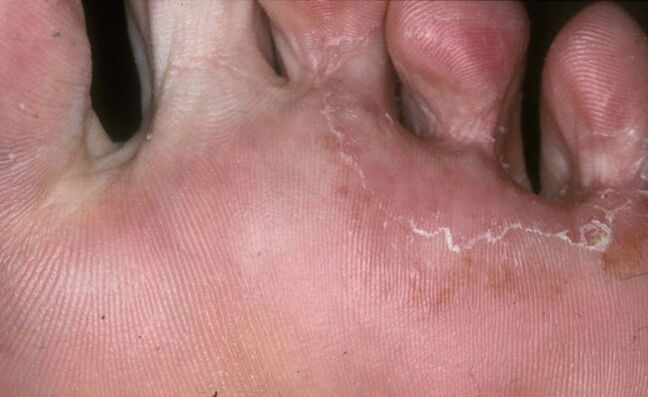Various fungi on human feet are called mycosis. When the skin is infected, the disease is called dermatophytosis (epidermis, Trichophyton) because the dermis is translated from Greek to skin. If the nail is affected, the disease is defined as onychomycosis.

The cause of the disease
Fungus on the feet is a common disease all over the world. It is more common in cities than in rural areas. People at risk for foot fungus include athletes, shower workers, and hot workshop workers. Children have thin skin and cannot be immune to external factors, so they are also prone to fungal diseases. Another reason is that physical diseases or congenital diseases lead to increased sweating of the feet. Dermatologists believe that the risk of foot fungal infections increases with age. Factors that cause disease:
- Wearing closed, uncomfortable faux leather shoes;
- Humid and warm environment, usually used when wearing shoes;
- Violation of the blood supply to the limbs;
- Often go to crowded places;
- Weakness or abnormal function of the immune system;
- Wearing stranger's shoes.
Rapid infection
Dermatomycosis of the feet can easily spread from sick people to healthy people in public places. Infection occurs through contact with surfaces: floors, household items, personal hygiene products, other people's shoes. Fungi are spread by direct contact and reproduce very quickly, which is why they are easily infected. It is not ruled out that the spread of fungus through pedicure tools and towels in hair salons. This disease affects the skin of the feet. This is especially common among men, as they wear closed shoes most of the time. Often go to gymnasiums, bathrooms, military service, instead of always wearing shoes of your own size-all of these create favorable conditions for the growth of pathogenic bacteria. The unventilated area of the room is conducive to the growth of disease-causing fungi. The spread of pathogenic bacteria is very fast. The place where the fungus predominates is the space between the toes and fingers. Saunas and bathrooms are characterized by high humidity and high temperature, which are very suitable for the development of pathogenic microflora.
Fungal infections can be direct or indirect. Directly, you can become infected through direct contact with a sick person. Indirect contamination involves the use of items used by the patient.
Manifestations of mycosis
The first symptom of the disease is the appearance of scaly skin on the feet. Through these factors, infection occurs. Increased sweating is a favorable factor for microbial reproduction, because changes in sweat composition become nutrients for the growth of pathogenic bacteria.

Dirt and thread residue in the socks can also collect between the toes. When fungal infections are added to the listed factors, redness occurs. The affected area started to feel unbearable itching, making people feel uncomfortable. The skin begins to peel off, which can cause cracks to appear. When walking, there will be unpleasant pain due to wounds on the skin of the feet. The skin begins to thicken and the infection will spread to the nails. If left untreated, the fungal disease can spread and affect the nails, thereby destroying the nails. The nail plate first changes its color to white. Subsequently, it will peel off. A gap is formed between the nail plate and the nail bed. There are fungi on the feet, which can produce an unpleasant smell. In winter, when wearing closed shoes, the legs are not ventilated, and the intensity of foot lesions increases. For the treatment of this pathology, the correct formulation and correct diagnosis are necessary because there are many types of fungal pathogens.
Main disease types
- The membrane type (three-layer form) is the most common. A fungal infection was observed between the fifth and fourth toes. The skin gradually acquires a scaly structure with cracked elements. Sometimes bacterial infections attach to the fungus, which can cause more damage to the skin of the legs.
- Moccasin-like type. It is manifested by foot pain. Then the skin thickens, thickens and cracks. Severe fungal lesions can capture the nails, and over time, the nails will begin to chip and peel off.
- Vesicle type (dysdrodrotic form). It is evidenced by the appearance of blisters under the fluid-filled skin. It usually goes together with bacterial infections.
Photo of the fungus with the name on the leg

There are various types of fungi, which correspond to various diseases. There are four most common types of fungi that cause foot damage.
- Trichophytonrubrum is full of erythrasma.
- Trichophyton interdigitale affects the skin between the fingers and affects the entire foot of the disease. Cause epidermal ringworm disease.
- Trichophyton trichophyton causes complete epidermal growth.
- Candida albicans is a female fungus. It can cause foot candidiasis, but this is rare.

Epidermal ringworm and Trichophyton (dermatophytes) are skin diseases, collectively referred to as foot mycosis, which are caused by parasitic fungi of the genus Dermatophytes.
classification
Dermatophytes fungi:
- Microspores
- Epidermal plant
- t.
Molds that cause fungal diseases:
- Henderson Noura
- Seaweed;
- s.
Yeast pathogenic fungi:
- Pityrosporum
- Candida
- Cryptococcus
- malassezia;
- Ball algae;
- Tissue cytoplasm
- w.
Precaution

Since fungi like warm, humid habitats, it is necessary to destroy these conditions to get rid of them. Therefore, to prevent fungus, the feet must be clean and dry. It is important to change socks and dry shoes in time. There are special antiperspirants on sale that will prevent the development of pathogenic microorganisms. It is best to choose leather shoes to maintain the normal metabolic process between the foot and the environment. The feet sweat less and will not create conditions for fungi to multiply. It is recommended to wear socks at home, and then take them off and wash them. Microbes and dirt will accumulate on household shoes.
Because you don't know the existence of other people's diseases, you only need to use your own things. Your immunity may not be able to cope with the pathogen and become infected. You need to wear shoes more often. When visiting public places, it is recommended to bring personal hygiene products with you. Do not walk barefoot on the floors of swimming pools and showers. The use of preventive antifungal ointments and ointments can also help. After all, swimming pools, changing rooms, saunas and other rooms with high humidity are places where fungi can grow. In the bathroom at home, it is best not to use porous carpet.
Risk Group
Some people are more susceptible to this disease than others. This may be caused by physical problems, such as:
- Excess weight;
- Violation of blood circulation in the legs;
- Flat feet and foot deformities;
- Impaired immune system;
- People are under pressure
- After antibiotic treatment.
Diagnosis of foot mycosis
The doctor performed a detailed examination of the feet and lodged a complaint. A skin sample is taken from the patient for fungal testing. Obtained a piece of skin and slightly scratched the foot. For analysis, the nail was cut from the fungus infection. The presence of mycosis is confirmed by special tests. In order to identify the type of fungus, it is cultured, that is, grown. In rare cases, if the disease is advanced, a biopsy can be given to the patient. In this case, the prepared material is checked under a microscope.
treatment method
In order to get results from treatment, it is necessary to understand the type of fungus and whether there is an infection (if any). The degree of damage is also considered.
The basis of membrane treatment looks like applying antifungal drugs to the affected area. It is convenient even at home. These drugs can stop the growth of bacteria or slow the spread of disease. Many of these drugs can be purchased over the counter without a prescription. The effect of the substance occurs locally, when applied to the affected skin. It is important to monitor the progress of treatment, if it does not improve, the drug may not help you.

If the medicament used is not effective, it is necessary to consult a dermatologist again for other treatments. You may need to prescribe stronger medicines. In particularly severe cases during the course of the disease, tablets should be taken. Many drugs have side effects, so it is necessary to monitor blood counts during treatment. The fungus is difficult to cure completely because it will recur. Treatment should not be interrupted, otherwise the mushrooms may develop resistance to the medicinal ingredients that affect them. During the treatment, it is necessary to monitor the cleanliness and dryness of the feet. For a form of infection similar to moccasins, onychomycosis (ie, damaged nails) often occurs. Because the skin on the legs becomes thicker and it is difficult for the drug to penetrate into the body, this disease is more difficult to cure. In this case, the standard medicine "does not work" and other therapies in the form of pills have been prescribed. Onychomycosis-damage to the toenails by dermatophytes. The disease may also be caused by yeast and mold. There are several types of onychomycosis:
- The far end is not complete. According to the different areas of the nail plate lesions, it can be divided into three degrees of damage: If the nail is divided into one part and conditionally divided into three parts (depth), the number of lesions accounting for up to two-thirds of its lesions will correspond toIn the first two stages of the disease. When the fungus infests more than 2/3 of the nails, this is already 3 degrees. In this case, the root (matrix) of the nail is related to the development of the disease, and sometimes it is also related to the skin folds on the side of the nail, which is called peripal bulge.
- Proximal sublingual. The hole on the back of the nail plate;
- Light white. This type of onychomycosis is very common on the feet.
- Completely malnourished. The final finishing stage.
In the blister type, the doctor may prescribe the top of the blister. Then, all the liquid flowing out of it is sucked dry. Dry the area and apply an anti-fungal cream or special compress on it. If a bacterial infection is confirmed, a course of antibiotics should be prescribed. Sometimes the disease is accompanied by fever. Acute infections respond better to treatment than chronic fungi and slow processes. In severe cases, hormonal drugs should be prescribed. Take anti-fungal medications until fully recovered. It is possible that not all fungi will die, and the withdrawal of medications will lead to recurrence of the disease.
If left untreated, the disease will become a chronic disease and will develop into a serious bacterial infection. In addition to the feet, the skin of the toes may also be related to diseases.
Traditional medicine provides compressed preparations and lotions for the treatment of nail fungus with anti-inflammatory tea tree oil and garlic. Washing with conventional detergents does not always kill disease-causing bacteria. To remove fungi from clothes, linen should be washed in hot water or boiled as much as possible. We recommend using bleach and hot ironing.
























